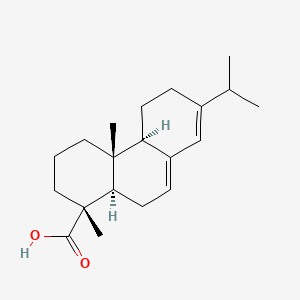| MeSH term | MeSH ID | Detail |
|---|---|---|
| Asthma | D001249 | 52 associated lipids |
| Cell Transformation, Neoplastic | D002471 | 126 associated lipids |
| Dermatitis, Contact | D003877 | 59 associated lipids |
| Edema | D004487 | 152 associated lipids |
| Occupational Diseases | D009784 | 42 associated lipids |
| Psoriasis | D011565 | 47 associated lipids |
| Ulcer | D014456 | 16 associated lipids |
| Weight Gain | D015430 | 101 associated lipids |
Abietic acid
Abietic acid is a lipid of Prenol Lipids (PR) class. Abietic acid is associated with abnormalities such as Hand eczema, Dermatitis, Vitelliform dystrophy, Wiskott-Aldrich Syndrome and Dehydration. The involved functions are known as Process, Oxidation, Anabolism, Transmembrane Transport and physiological aspects. Abietic acid often locates in Membrane, Protoplasm, Microsomes and Cellular Membrane. The associated genes with Abietic acid are SLC33A1 gene and ABCG2 gene. The related lipids are Pinene.
Cross Reference
Introduction
To understand associated biological information of Abietic acid, we collected biological information of abnormalities, associated pathways, cellular/molecular locations, biological functions, related genes/proteins, lipids and common seen animal/experimental models with organized paragraphs from literatures.
What diseases are associated with Abietic acid?
Abietic acid is suspected in Hand eczema, Dermatitis, Dehydration and other diseases in descending order of the highest number of associated sentences.
Related references are mostly published in these journals:
| Disease | Cross reference | Weighted score | Related literature |
|---|
Possible diseases from mapped MeSH terms on references
We collected disease MeSH terms mapped to the references associated with Abietic acid
PubChem Associated disorders and diseases
What pathways are associated with Abietic acid
There are no associated biomedical information in the current reference collection.
PubChem Biomolecular Interactions and Pathways
Link to PubChem Biomolecular Interactions and PathwaysWhat cellular locations are associated with Abietic acid?
Visualization in cellular structure
Associated locations are in red color. Not associated locations are in black.
Related references are published most in these journals:
| Location | Cross reference | Weighted score | Related literatures |
|---|
What functions are associated with Abietic acid?
Related references are published most in these journals:
| Function | Cross reference | Weighted score | Related literatures |
|---|
What lipids are associated with Abietic acid?
Related references are published most in these journals:
| Lipid concept | Cross reference | Weighted score | Related literatures |
|---|
What genes are associated with Abietic acid?
Related references are published most in these journals:
| Gene | Cross reference | Weighted score | Related literatures |
|---|
What common seen animal models are associated with Abietic acid?
There are no associated biomedical information in the current reference collection.
NCBI Entrez Crosslinks
All references with Abietic acid
Download all related citations| Authors | Title | Published | Journal | PubMed Link |
|---|---|---|---|---|
| Karlberg AT and Lidén C | Colophony (rosin) in newspapers may contribute to hand eczema. | 1992 | Br. J. Dermatol. | pmid:1536781 |
| Sadhra S et al. | Identification of contact allergens in unmodified rosin using a combination of patch testing and analytical chemistry techniques. | 1996 | Br. J. Dermatol. | pmid:8733367 |
| Sousa Neto MD et al. | The influence of different grades of rosins and hydrogenated resins on the powder-liquid ratio of Grossman cements. | 1998 | Braz Dent J | pmid:9835799 |
| Fâhraeus-Van Ree GE and Payne JF | Enzyme cytochemical responses of mussels (Mytilus edulis) to resin acid constituents of pulp mill effluents. | 1999 | Bull Environ Contam Toxicol | pmid:10501718 |
| Belmonte M et al. | Effect of aerobic sludge with increasing level of adaptation on abietic acid biodegradation. | 2006 | Bull Environ Contam Toxicol | pmid:17219306 |
| Morgan CA and Wyndham RC | Characterization of tdt genes for the degradation of tricyclic diterpenes by Pseudomonas diterpeniphila A19-6a. | 2002 | Can. J. Microbiol. | pmid:11888163 |
| Shpatov AV et al. | Lipophilic extracts from needles and defoliated twigs of Pinus pumila from two different populations. | 2013 | Chem. Biodivers. | pmid:23418167 |
| Fujita Y et al. | New hypocholesterolemic abietamide derivatives. I. Structure-activity relationship. | 1980 | Chem. Pharm. Bull. | pmid:7389019 |
| Frija LM et al. | Isolation, chemical, and biotransformation routes of labdane-type diterpenes. | 2011 | Chem. Rev. | pmid:21618966 |
| Bleif S et al. | Identification of CYP106A2 as a regioselective allylic bacterial diterpene hydroxylase. | 2011 | Chembiochem | pmid:21271628 |
